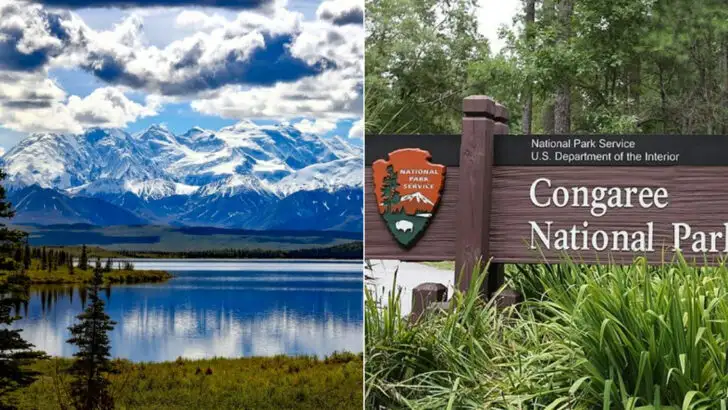While Yellowstone is undoubtedly iconic, there are hidden gems across America that offer unparalleled wildlife experiences without the crowds. Explore these 15 parks where nature’s spectacle unfolds in tranquility.
Denali National Park (Alaska)
In the shadow of North America’s tallest peak, Denali National Park offers a wilderness adventure like no other. The park is home to grizzly bears, caribou, and wolves, roaming freely across its vast tundra.
Visitors can explore the park via bus tours, offering a unique chance to glimpse wildlife in their natural habitat. The landscape’s rugged beauty is complemented by the quiet serenity of unspoiled nature.
Did you know that Denali National Park only has one road? This limits vehicle access, ensuring minimal human impact on the wildlife. A true sanctuary for animal lovers.
Katmai National Park (Alaska)
Imagine watching brown bears fish for salmon at Brooks Falls. Katmai National Park provides a front-row seat to one of nature’s most powerful spectacles.
The park’s remote location ensures fewer visitors, allowing for a more intimate wildlife experience. It’s a place of patience and observation, where the natural world thrives unencumbered.
Beyond bears, Katmai is a landscape of volcanoes and rivers, offering adventurous travelers a rugged escape. The park’s slow pace allows for deliberate exploration, making each moment meaningful.
Isle Royale National Park (Michigan)
On an island isolated in Lake Superior, Isle Royale National Park harbors a unique ecosystem. The interplay between moose and wolves offers insights into predator-prey dynamics.
With no roads, the island invites exploration by foot or kayak, fostering a sense of connection with nature. The park’s quiet isolation enhances the experience of encountering its majestic inhabitants.
A surprising fact: Isle Royale is closer to Canada than to mainland USA. This geographical quirk adds to its allure, making it a destination for those seeking solitude and adventure.
Big Bend National Park (Texas)
Nestled along the Rio Grande, Big Bend National Park boasts a rich tapestry of desert flora and fauna. Bird enthusiasts will delight in its avian diversity, making it a premier birdwatching destination.
The park’s varied landscapes, from mountains to river canyons, support a wide range of wildlife. Each turn reveals a new facet of its complex ecosystem.
The remoteness of Big Bend ensures tranquil exploration, free from crowds. It’s a place where the desert’s quiet beauty speaks volumes, offering a serene escape for nature lovers.
Theodore Roosevelt National Park (North Dakota)
Named after the conservationist president, Theodore Roosevelt National Park is a testament to America’s natural heritage. Bison roam the badlands, embodying the spirit of the Wild West.
Visitors can venture through prairies and canyons, discovering the park’s diverse habitats. The landscape’s stark beauty is matched by its rich history.
The park’s namesake, Theodore Roosevelt, once ranched in the area, drawn by its rugged charm. Today, it remains a living tribute to his enduring legacy.
Olympic National Park (Washington)
Olympic National Park offers a world of contrasts, from misty rainforests to rugged coastlines. Elk wander through lush greenery, while seals bask along the shore.
The park’s diverse ecosystems support a wide array of wildlife, with each area offering unique encounters. Visitors can transition from rainforest walks to beachcombing in a single day.
A fascinating aspect of Olympic is its three distinct ecosystems, making it a microcosm of the Pacific Northwest. It’s a natural wonderland, perfect for those seeking variety in their adventures.
Kenai Fjords National Park (Alaska)
Where glaciers meet the sea, Kenai Fjords National Park offers a breathtaking marine wildlife experience. Sea otters and seals thrive in the icy waters, creating a dynamic and vibrant ecosystem.
Visitors can explore the park through boat tours, witnessing the grandeur of calving glaciers and the delicate balance of marine life. Each journey reveals a new perspective on this unique environment.
The park’s remote location in Alaska ensures a tranquil experience, unmarred by crowds. It’s a place where nature’s raw power and beauty are on full display.
Wrangell–St. Elias National Park (Alaska)
As the largest national park in the United States, Wrangell–St. Elias offers a sense of scale and solitude unmatched elsewhere. Its vast wilderness is home to an array of wildlife, from Dall sheep to grizzly bears.
The park’s remote location appeals to adventurous souls seeking off-the-beaten-path experiences. Mountains dominate the skyline, creating a dramatic backdrop for exploration.
Part of a UNESCO World Heritage site, Wrangell–St. Elias embodies the spirit of untouched wilderness. It’s a place where the landscape’s sheer size inspires awe and wonder.
Gates of the Arctic National Park (Alaska)
In the heart of Alaska, Gates of the Arctic National Park offers a pristine wilderness experience. Caribou herds migrate across its vast tundra, a sight of natural splendor.
The park’s lack of roads ensures a remote and unspoiled environment, perfect for those seeking solitude. Rivers carve through the landscape, providing lifelines for its diverse wildlife.
Gates of the Arctic is a place of true wilderness, where human footprints are fleeting. Its untouched beauty beckons those ready for an adventure in one of the last great wild places.
Channel Islands National Park (California)
Off the coast of California, Channel Islands National Park is a treasure trove of biodiversity. The islands’ isolation has led to unique species, from island foxes to vibrant marine life.
Explorers can delve into the park’s underwater world, where kelp forests sway with the ocean’s rhythm. Above, the islands offer trails leading to breathtaking vistas.
A true natural laboratory, Channel Islands is often called the “Galápagos of North America.” Its rich ecosystems provide endless opportunities for discovery and exploration.
Voyageurs National Park (Minnesota)
Water dominates Voyageurs National Park, where lakes and rivers define the landscape. Moose and eagles thrive here, embodying the spirit of the Northwoods.
Visitors can explore the park by canoe or kayak, navigating its interconnected waterways. Each journey offers a chance to encounter wildlife in a peaceful setting.
The park’s name honors the French-Canadian voyageurs who once traversed these waters. Today, it remains a place of adventure and tranquility, perfect for those seeking a water-centric escape.
Congaree National Park (South Carolina)
Congaree National Park offers a glimpse into a primordial world, where towering trees form an ancient canopy. The park’s floodplain forests are rich in biodiversity, providing a haven for diverse wildlife.
Visitors can explore the park’s boardwalk trails, immersing themselves in its lush beauty. The river winds through the landscape, offering opportunities for serene paddling.
A unique feature of Congaree is its champion trees, some of the tallest in the Eastern United States. It’s a living museum of natural history, offering peace and inspiration.
Black Canyon of the Gunnison National Park (Colorado)
With its steep and rugged cliffs, Black Canyon of the Gunnison National Park offers a striking landscape of raw beauty. Bighorn sheep traverse its dramatic terrain, adding life to the rocky expanse.
Visitors are treated to quiet trails that wind through the canyon, revealing breathtaking vistas at every turn. The sheer walls create a sense of awe and wonder.
A remarkable feature of the park is its dark night skies, offering stellar stargazing opportunities. It’s a place where the earth’s ancient history is etched into every rock face.
Guadalupe Mountains National Park (Texas)
In the high deserts of Texas, Guadalupe Mountains National Park rises with rugged elegance. Its cooler summits provide refuge for diverse wildlife, from mule deer to mountain lions.
Hikers can ascend to panoramic views, where the desert unfolds in a tapestry of color and life. Each trail offers a unique perspective on this stunning landscape.
The park is home to the highest peak in Texas, Guadalupe Peak, a testament to the area’s geological grandeur. It’s a destination for those seeking both adventure and tranquility.
Dry Tortugas National Park (Florida)
Off the coast of Florida, Dry Tortugas National Park is a marine paradise. Its vibrant coral reefs are home to sea turtles and a myriad of seabirds, creating a lively underwater ecosystem.
Visitors can explore Fort Jefferson, a testament to the park’s historical significance. The surrounding waters invite snorkeling adventures, revealing a world of colorful marine life.
A unique aspect of Dry Tortugas is its isolation, accessible only by boat or seaplane. This remoteness ensures a serene experience, perfect for those seeking a tropical escape.

